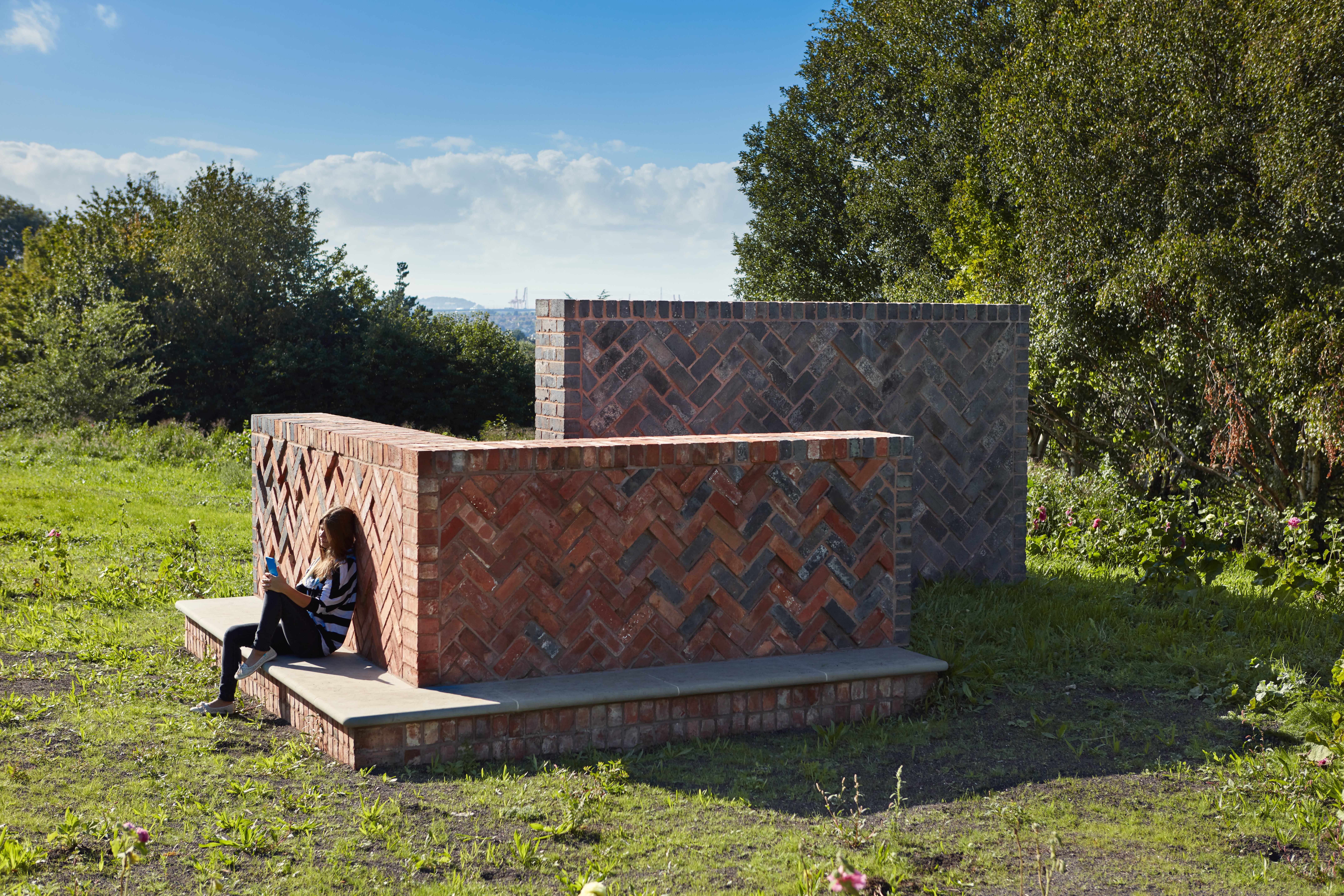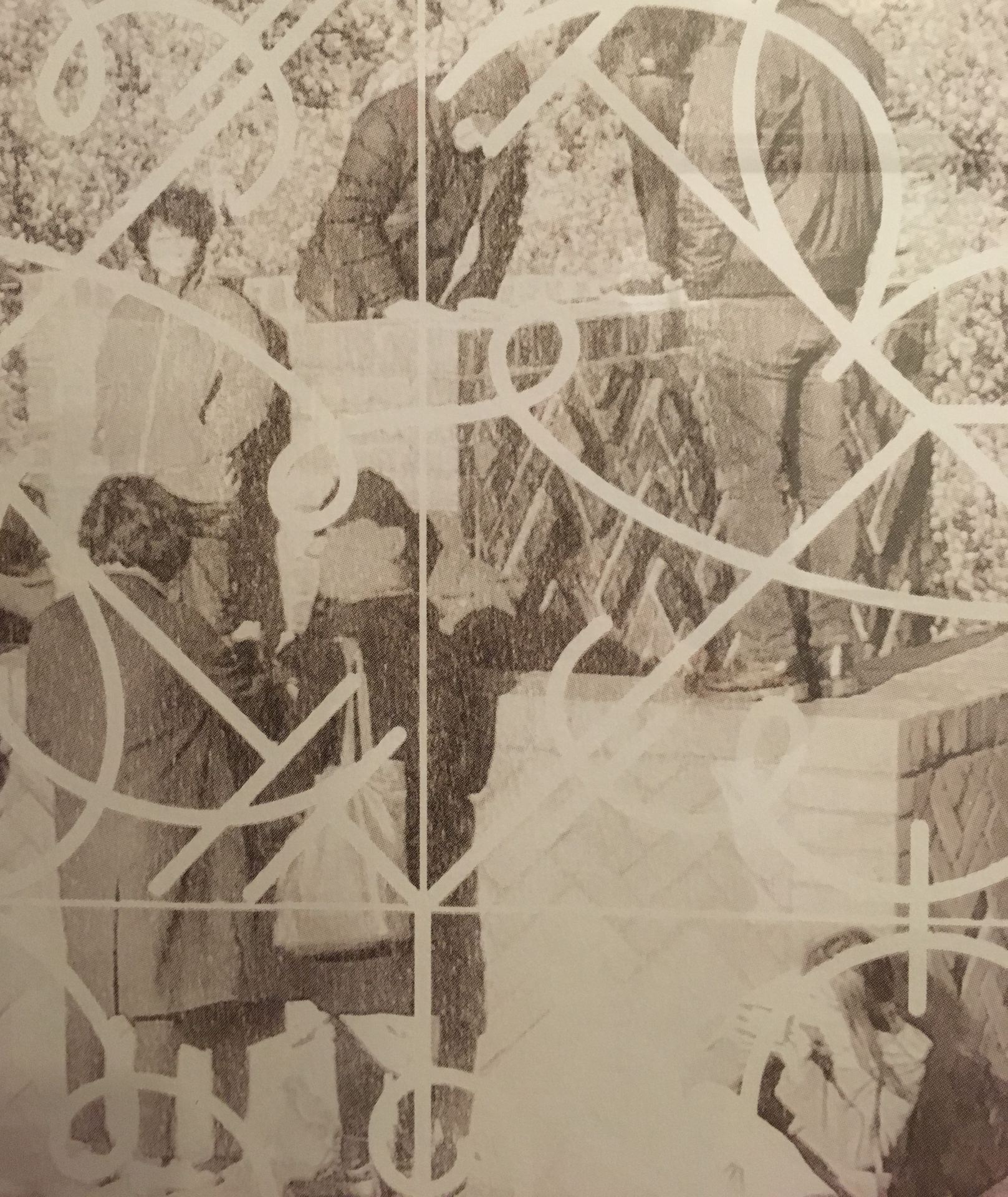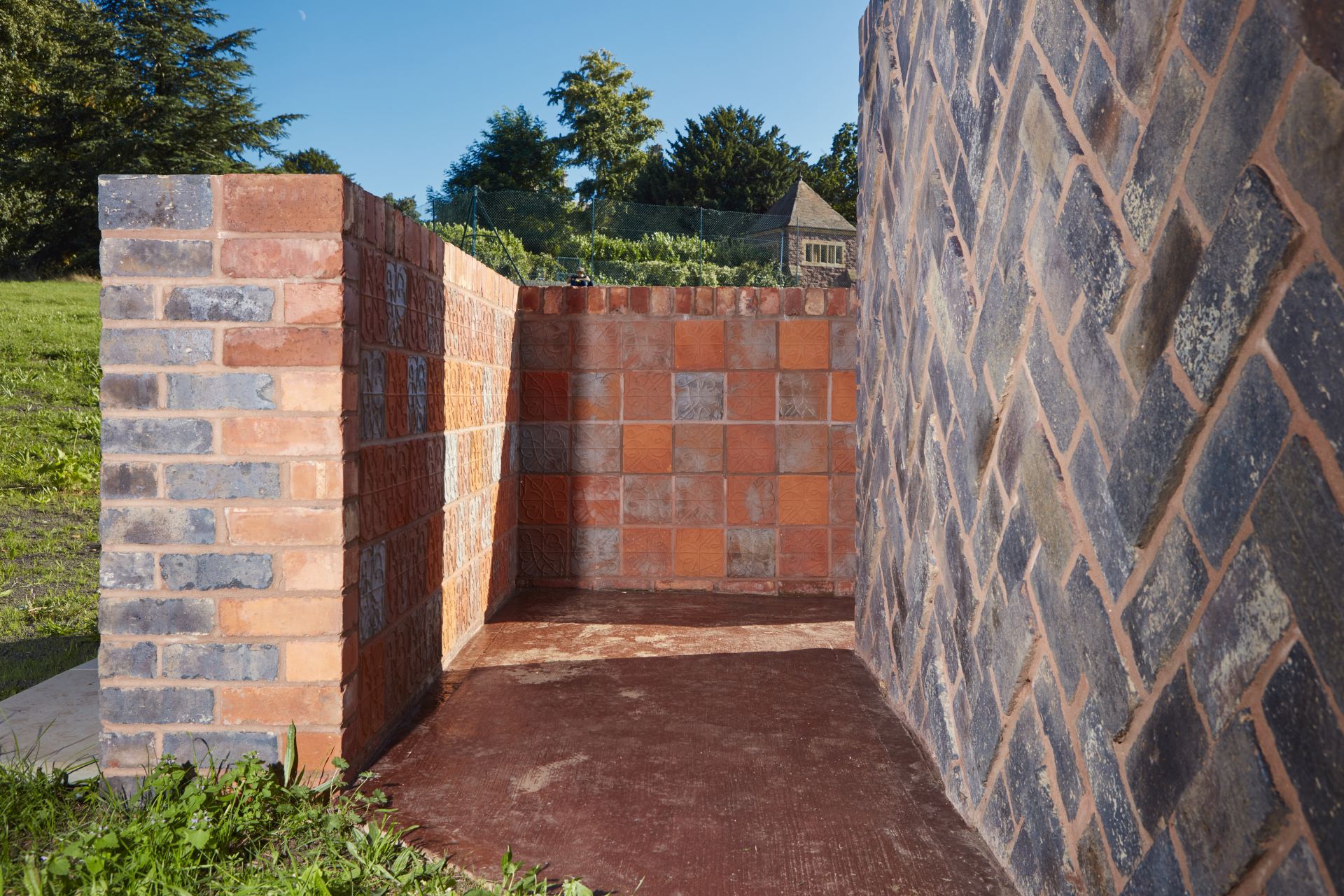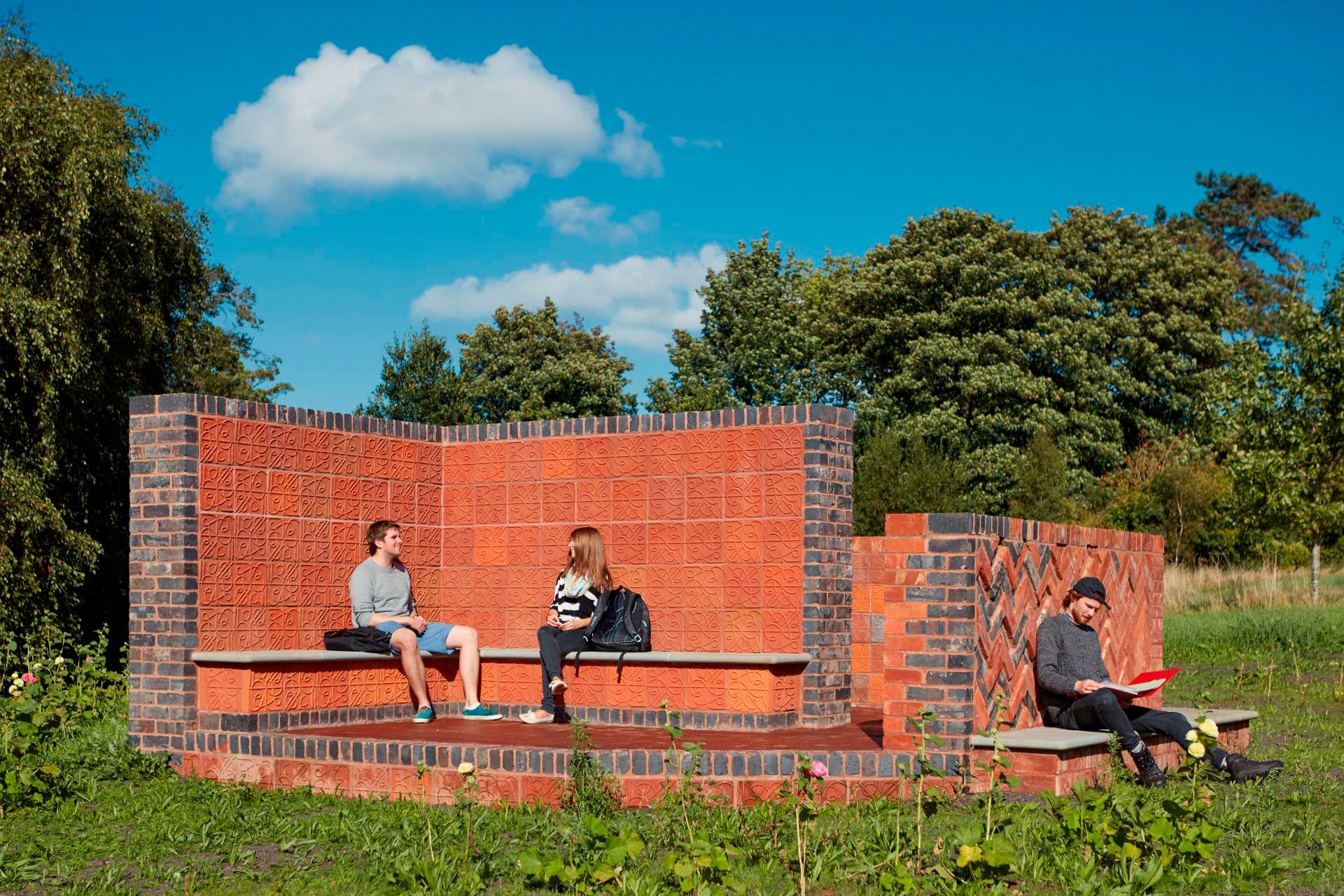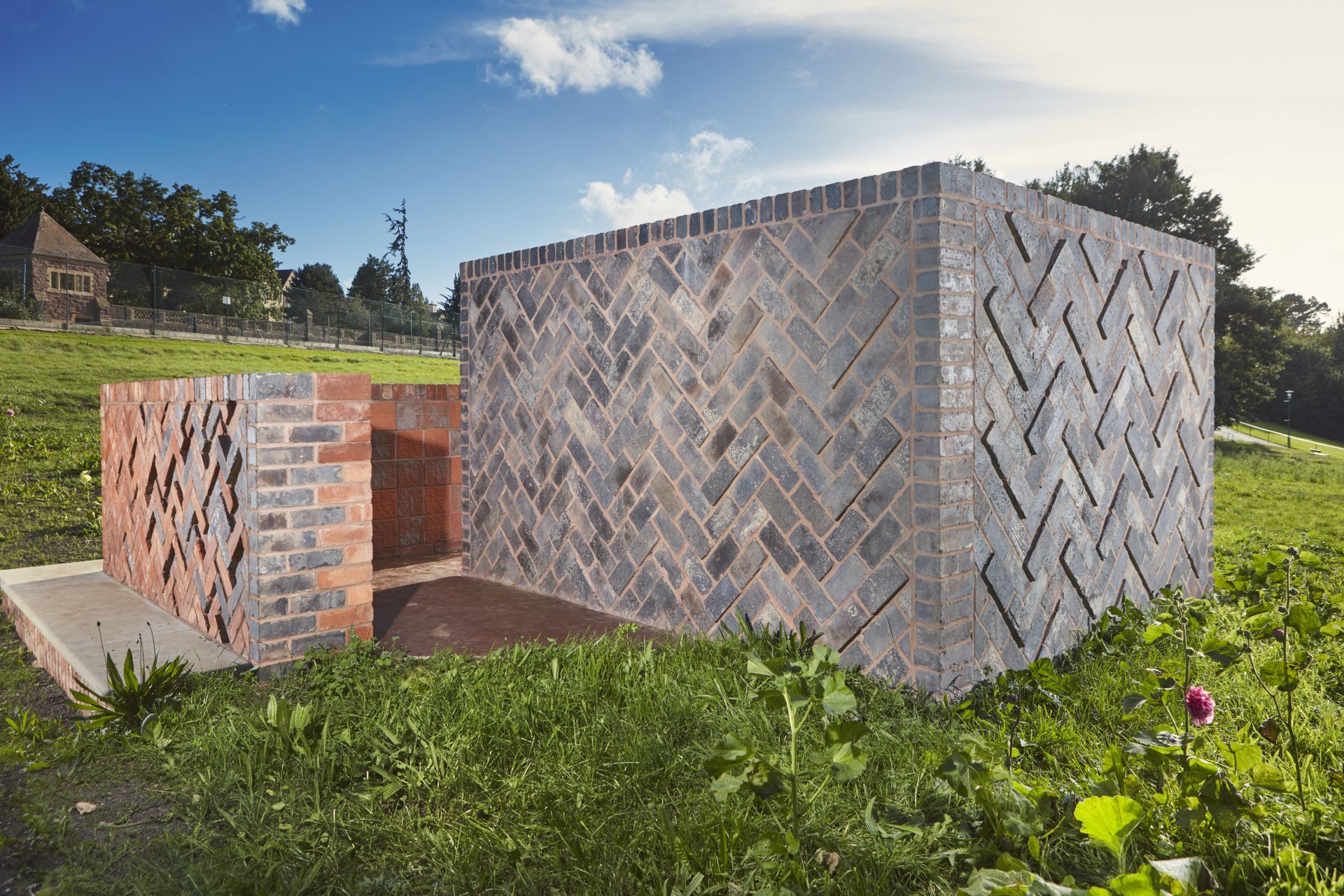Edith and Hans (2016) by London-based artist Sarah Staton is a permanently sited public artwork situated in the grounds of the University of Bristol’s Stoke Bishop campus in north Bristol.
This commission was curated and produced by Field Art Projects in 2012 as part of a public art strategy and programme for the University of Bristol’s residential site at Stoke Bishop.
Edith and Hans has been described as ‘somewhere between a ruin and an archaeological find’. Conceived as an outdoor room, it is composed of two L-shaped walls, one tucked inside the other to create a corridor. Benches run along the inner corner of one wall and along the outside of the other, providing opportunities to face one another or to sit looking in opposite directions.
Located in the meadow between the Wills Hall and Hiatt Baker halls of residence, this social sculpture invites us in. The artist describes the space it provides as a ‘place for student lingering and languishing and loitering’.
Oriented towards the south west, the tiles on the sculpture capture the warmth from the afternoon sun. There are views across Avonmouth and into Wales in one direction, and a view up to Wills Hall in the other.
In an age when so many artworks are conceived to be photographed, when unconscious concessions are made for maximum online popularity, and when the circulation of art is so frequently a function of its representation in digital photographs and on social media, what does it mean for a work to privilege people’s presence, to ask for our time and our touch?
Ellen De Mara Wachter on Edith and Hans
Above is a detail from ‘Edith and Hans and the Currency Mesh’ 2017 , a limited edition silkscreen print created in celebration of the opening of this social sculpture.
An Elizabethan planting scheme was created to surround the sculpture. Close to the sculpture these plants can be found: Alcea Rosea (hollyhocks), Fritillaria Ussuriensis and Meleagris (snake’s head fritillary), Erythronium ‘pagoda’ (dog’s tooth violet).
Along the bank, grasses were planted: Panicum virgatum ‘Rehbraun’ (switch grass), Miscanthus sinensis ‘Zebrinus’ (Maiden grass), Hordeum jubatum (fox tail barley), with a line of Cornus sanguinea (dogwood Midwinter Fire) behind the grasses.
The sculpture is constructed from bespoke, artist-designed wood-fired tiles, reclaimed red and blue bricks and pennant stone and was inspired by Bristol’s rich brick-making history.
Bristol’s association with bricks dates back to the 19th century when Charles Richardson, a railway engineer and friend of Isambard Kingdom Brunel, noticed the high-quality clay that was dug out in the process of building the Patchway tunnel for the Bristol and South Wales Railway. Due to the minerals in the soil, the bricks were produced in many colours – apart from the traditional red, there were also yellow, buff and blue bricks.
During my research I was struck by the prevalence of brickwork and decorative detailing in and around the Stoke Bishop site. I then discovered that Bristol has a rich history of brickmaking, many examples of which can be found in Bristol Museum & Art Gallery. Edith and Hans has been built using local reclaimed bricks and decorated with a bespoke tile that reflects both the University’s community and my émigré family connections.
The sculptures are named after the artist’s grandmother Edith and great uncle Hans who both had personal connections to Bristol. As Director of Bristol Museum and Art Gallery, Hans knew the Wills and Hiatt Baker families, who the adjacent halls of residence are named after.
The tile design for Edith and Hans is formed like a monograph, composed of the symbols for major global currencies including the yen, euro, pound, dollar and rupee. It celebrates the University of Bristol’s diverse global community and refers to the many countries across three continents Edith and Hans called home during their lifetimes.
Sarah Staton
Sarah Staton ( b. 1961) is a visual artist based in London. Alongside her commissioned work and studio work, Staton is a Senior Tutor at the Royal College of Art where she works with students on the Sculpture MA. Staton combines sculpture with design, landscape, and architecture, producing an expanded notion of sculpture with a regard for sculpture’s social potential.
Staton’s work is held in collections across the world including the Arts Council England, British Museum, Henry Moore Institute, MIMA Sunderland, South London Gallery, Tate, as well as private collections in Europe North America and Japan.
Field Art Projects
Field Art Projects is an art consultancy based in Bristol run by curator and commissioner Theresa Bergne. Established in 1999, the organisation has more than two decades of experience commissioning visual artists, designers and performers to create permanent and temporary public artworks and events.
Field Art Projects wrote the public art strategy for the University of Bristol’s residential site at Stoke Bishop in 2012 and delivered the programme.
Fabrication
The artwork was constructed by Bristol based building contractors Aztech Building Services, with groundworks by Earthworks. The bespoke tiles were produced to the artist’s design by specialist brickmakers H G Matthews, and reclaimed bricks were sourced from Ronson Reclaim in Gloucestershire. The pennant sandstone was sourced from Royal Forest Pennant in Gloucestershire. The installation was carried out by Aztech Construction and by the University’s Estates Office.
Sarah has created an extraordinary permanent artwork for Stoke Bishop, which will no doubt be a popular spot for our students and the public to enjoy for years to come. What is so special about Edith and Hans is how it combines form with function to respond to the natural environment and enhance this beautiful open space in Stoke Bishop.
Professor Guy Orpen, former Pro Vice Chancellor.
Location and access
Wills Hall: Parrys Lane, Stoke Bishop, Bristol BS9 1AE
What3Words location: stone.plates.long
Edith and Hans is free to visit and open to all. It is permanently located in a meadow at the University’s Stoke Bishop Campus – in the North Residential Village; a campus of accommodation housing over 2,000 students. The meadow is closest to the Wills Hall of residence and the Hiatt Baker Hall of residence, which are two miles from the University’s Clifton campus. There is a regular bus service running to the Clifton Campus.
Please note that whilst this artwork is open to all; access to the site may be limited for maintenance or other activities at the discretion of the University.
Further resources
Art Critic Ellen Mara De Wachter was invited to write about Edith and Hans in 2016.
Download Ellen Mara De Wachter’s commissioned response. (PDF, 1.2MB)

